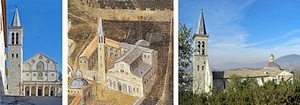The earliest surviving reference to the church of "Sancta Maria Episcopii Spolitani" dates to 956. This church was documented again in 1067, along with the adjacent "trivuna Sancti Primiani", which must refer to the tribune of a church dedicated to St Primianus. Both of these earlier structures are discussed more fully in the page on the early history of the Duomo.
The Duomo was probably destroyed in 1155, when the Emperor Frederick I sacked Spoleto. Shortly after his consecration in 1177, Bishop Transarico moved to San Gregorio Maggiore so that the old Palazzo Vescovile could be demolished in order to make way for the construction of the present Duomo. Frederick I finally made his peace with the city in 1185: he seems to have given a precious icon of the Virgin, the so-called SS Icone, to the Duomo as a token of the city’s return to favour.
-
✴Pope Innocent III consecrated an altar in the Duomo in 1198, while the church was still in construction.
-
✴Construction must have been approaching completion in 1207, the date inscribed on the mosaic on the facade (see the page on the exterior).
-
✴The church was probably complete when Pope Honorius III consecrated it in ca. 1216.
-
✴Pope Gregory IX canonised St Antony of Padua here in 1232.
Building History
The church was originally in the form of a Latin cross, with a nave and two aisles. Two five-sided chapels were built at the ends of the transept in the 14th century:
-
✴the Cappella di Santa Caterina on the right; and
-
✴the Cappella di Sant’ Anna on the left.
Traces of frescoes of the Last Judgement that Bishop Gallardus (1372-9) commissioned for the counter-facade survive (see the page on the Interior). Others were commissioned for the walls in 1404, although no trace of these survives.
Eroli Bishops
The fabric of the Duomo was modernised in the Renaissance style during the time of the three successive bishops from the Eroli family:
-
✴Bishop Berardo Eroli (1448 – 74);
-
✴Bishop Costantino Eroli (1474 - 1500); and
-
✴Bishop Francesco Eroli (1500 - 40).
They were closely involved in a number of important commissions, including:
-
✴the frescoes in the apse (1467-9) by Filippo Lippi;
-
✴a series of new chapels (1469) along the aisles;
-
✴the portico (1491-1504), which replaced the original structure ; and
-
✴the Eroli Chapels (ca. 1497-1540).
The Cappella delle Reliquie was built off the left aisle in 1540.
17th Century
The middle image comes from a painting (ca. 1636) of
Pope Leo III arriving at Spoleto (Pinacoteca ?)
The Cappella della SS Icone was built to the right of the apse in 1623-6.
Structural problems in the Duomo emerged in 1638, Cardinal Francesco Barberini seems to have taken responsibility for its re-modelling. The inscription on the counter-facade records that the work was complete by 1644. Comparison of the images above illustrates the main features of the re-modelling:
-
✴The nave was widened, the narrowed aisle were increased in height, and the upper part of the facade was extended to reflect these internal changes.
-
✴A cupola was built over the crossing.
-
✴the Cappella di Santa Caterina on the right, which had been decorated in 1597 by Benedetto Gelosi, was demolished; and
-
✴the Cappella di Sant’ Anna on the left, which had been decorated in 1597 by Cesare Glandi, was reduced in size.
The interior of the Duomo was re-modelled in the decades after 1644:
-
✴The old high altar was demolished in 1653, at which point a number of relics were recovered that were believed to include the cranium of St Primianus.
-
✴In 1660, during work to lower the floor of the presbytery, other relics were discovered along with an inscription that identified them as those of St Emilianus. They were translated to Sant’ Emiliano in 1935.
The work was probably complete in 1680, a year after the death of Francesco Barberini, when Bishop Cardinal Cesare Facchinetti re-consecrated the Duomo.
Later History
The Duomo suffered in the earthquakes in 1703, 1767 and 1780. Bishop Francesco Maria Loccatelli commissioned the young architect Giuseppe Valadier to redesign the interior of the Duomo in 1785. This work, which led to the current neo-classical appearance of the interior, was complete by 1792, when the new high altar was consecrated.
The structure has suffered from further seismic activity and from underground water. It was most recently consolidated in 1904-6 and 1925-32.





